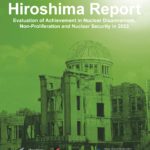Column 1 Prospects for U.S.-China Arms Control
Nobumasa Akiyama
Although the number of nuclear warheads has decreased by about eighty percent from its peak during the Cold War, there remain more than 13,000 nuclear warheads in the world. Furthermore, the proliferation of ballistic missiles—the means of delivery for these warheads— continues. Needless to say, it is particularly essential for the United States and Russia, which together possess more than 90% of the world’s total nuclear warheads, to negotiate a successor treaty to the New START Treaty in order to reduce nuclear risks and further reduce the quantity of nuclear weapons.
While China has been building up its nuclear arsenal as well, its nuclear capability has not yet reached a scale comparable to that of the United States and Russia. China has maintained, at least publicly, a stance that it will not accept arms control negotiation until the United States and Russia further reduce their nuclear arsenals. However, as the strategic confrontation between the United States and China becomes increasingly heated, an arms control arrangement between them would be far more desirable for both countries to avoid escalation to a nuclear armed conflict. It would also serve to stabilize the security environment in East Asia— an improvement over the current situation, in which no restrictions are imposed on strategic competition.
That said, establishing an arms control regime between the United States and China would require finding solutions to multiple simultaneous equations involving a number of asymmetries. The first asymmetry is that there is no common understanding among the United States, China, Japan, and other countries in the region as to the strategic equilibrium point at which stability could be achieved. China wants to eliminate U.S. interference and gain greater freedom of action in the Western Pacific. The United States wants to prevent China from upending the status quo of the international order and threatening the status of U.S. allies and partners. If there is no compromise in these strategic goals, the pursuit of arms control will be little more than a game of how to set the rules in one’s favor in the race for strategic advantage, with no concern for stability.
The second asymmetry is the quantitative imbalance of forces. In Asia, China has an overwhelming advantage over the United States in terms of medium-range ballistic missile capability, while the United States holds an overwhelming advantage in strategic nuclear weapons. In a situation where the two nations have different strategic goals and different views on deterrence, it is not feasible to regard the quantitative balance of weapons as a stable equilibrium point—a stark contract from the arms control agreements between the United States and Russia involving strategic nuclear weapons alone. Thus, in-depth strategic dialogue between the two countries will be necessary to establish a mutual understanding as a baseline for arms control negotiations.
The third asymmetry is the presence or absence of allies. From the perspective of U.S. allies and partners in the region, concerns about the “stability-instability paradox” will increase. That is to say, if the United States recognizes China’s supremacy at the theater level in Asia, in exchange for U.S.-China stability, regional countries will be exposed to increased Chinese pressure as China gains the ability to act freely in the region with no regard for U.S. interference. The result could be either a bandwagon effect with China, or U.S. allies and partners gaining an incentive to expand its own military forces. In this sense, the United States may face more constraints in envisioning an arms control modality.
There are yet additional factors that need to be mutually understood in order to define the “stability” that the United States and China seek to acquire through arms control, such as asymmetry of approach as well as progress in the military application of emerging technologies such as cyberwarfare, artificial intelligence, hypersonic gliders, remote sensing, and quantum computers. In this light, it is imperative that the United States and China do not wait for further U.S.-Russian progress in arms control negotiations, but rather pursue dialogue on arms control with the involvement of other countries in the region.
Nobumasa Akiyama: Professor, Hitotsubashi University






